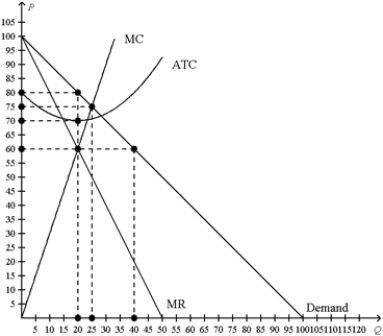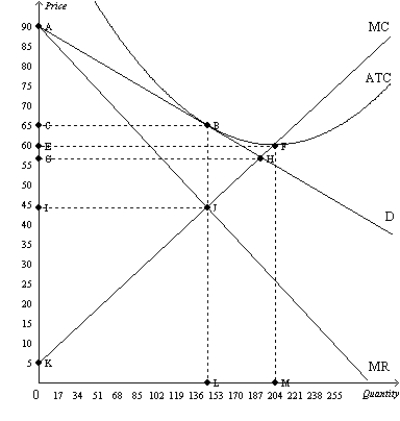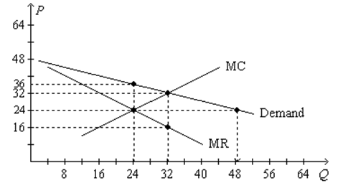B) False
Correct Answer

verified
Correct Answer
verified
Multiple Choice
The product-variety externality arises in monopolistically competitive markets because
A) firms produce with excess capacity.
B) firms try to differentiate their products.
C) firms would like to produce homogeneous products, but the large number of firms prohibits it.
D) entry and exit is restricted.
F) None of the above
Correct Answer

verified
Correct Answer
verified
Multiple Choice
Two college students, Mary and Maggie, are spending spring break in Florida. Mary buys a cup of coffee each morning at the local Starbucks rather than from one of the local coffee shops. Maggie claims that Mary is irrational because she never purchases Starbucks coffee at home, and Starbucks coffee costs more than the coffee sold by local shops. An economist would most likely explain Mary's behavior by suggesting that
A) Mary's behavior is rational, but Maggie's behavior is clearly irrational.
B) Mary's behavior is clearly irrational, but Maggie's behavior is rational.
C) the Starbucks brand name suggests consistent quality.
D) the advertising by Starbucks in Florida is more persuasive than the advertising by Starbucks in Mary and Maggie's home town.
F) None of the above
Correct Answer

verified
Correct Answer
verified
Multiple Choice
In markets where restrictions on advertising have been used to curtail competition, the U.S. courts have generally
A) referred the matters of advertising restrictions to executive regulators.
B) enforced industry-wide agreements to restrict advertising.
C) been silent on the effect of explicit advertising restrictions.
D) overturned laws that prohibit advertising.
F) All of the above
Correct Answer

verified
Correct Answer
verified
True/False
In the long run, monopolistically competitive firms produce where demand equals average total cost.
B) False
Correct Answer

verified
Correct Answer
verified
Multiple Choice
In a monopolistically competitive market, social welfare would be enhanced if
A) price equaled marginal cost.
B) government regulation eliminated the product-variety externality.
C) the government raised taxes to subsidize firms that price below average total cost.
D) there were fewer firms, making the industry closer to an oligopoly.
F) A) and B)
Correct Answer

verified
Correct Answer
verified
Multiple Choice
Figure 16-3
This figure depicts a situation in a monopolistically competitive market.  -Refer to Figure 16-3. What is the profit-maximizing price, quantity, and resulting profit?
-Refer to Figure 16-3. What is the profit-maximizing price, quantity, and resulting profit?
A) P=$60, Q=20 units, profit=$200
B) P=$80, Q=20 units, profit=$200
C) P=$75, Q=25 units, profit=$100
D) P=$60, Q=40 units, profit=$0
F) A) and D)
Correct Answer

verified
Correct Answer
verified
Multiple Choice
Two bottles of over-the-counter pain reliever sit side-by-side in a grocery store: Advil (a brand name) sells for $5.00, while Feel Better (not a brand name) sells for $2.50. In a typical day the store sells some of each type of pain reliever, which suggests that
A) no rational consumer would spend twice as much for Advil as he would for Feel Better.
B) some consumers must perceive that Advil is a higher quality product.
C) Advil has no incentive to maintain the quality of its product just because of the Advil brand name.
D) Advil spends money on advertising to reduce competition in the market.
F) B) and C)
Correct Answer

verified
Correct Answer
verified
Multiple Choice
In which of the following markets is economic profit driven to zero in the long run?
A) oligopoly
B) monopoly
C) monopolistic competition
D) cartels
F) A) and B)
Correct Answer

verified
Correct Answer
verified
Multiple Choice
One key difference between an oligopoly market and a competitive market is that oligopolistic firms
A) are price takers while competitive firms are not.
B) can affect the profit of other firms in the market by the choices they make while firms in competitive markets do not affect each other by the choices they make.
C) sell completely unrelated products while competitive firms do not.
D) sell their product at a price equal to marginal cost while competitive firms do not.
F) All of the above
Correct Answer

verified
Correct Answer
verified
Multiple Choice
When a firm exits a monopolistically competitive market, the individual demand curves faced by all remaining firms in that market will
A) shift in a direction that is unpredictable without further information.
B) shift to the right.
C) shift to the left.
D) remain unchanged. It is the supply curve that will shift.
F) All of the above
Correct Answer

verified
Correct Answer
verified
Multiple Choice
Monopolistic competition is an
A) inefficient market structure because there is deadweight loss.
B) inefficient market structure because price exceeds marginal cost.
C) efficient market structure because free entry drives long-run profits to zero.
D) Both a and b are correct.
F) A) and C)
Correct Answer

verified
Correct Answer
verified
Short Answer
Figure 16-14  -Refer to Figure 16-14. Use the letters to identify the deadweight loss from this firm producing at its profit-maximizing level of output.
-Refer to Figure 16-14. Use the letters to identify the deadweight loss from this firm producing at its profit-maximizing level of output.
Correct Answer

verified
Correct Answer
verified
Multiple Choice
Figure 16-2. The figure is drawn for a monopolistically competitive firm.
 -Refer to Figure 16-2. Suppose you were to add the ATC curve to the diagram to show the firm in a situation of long-run equilibrium. You would draw the ATC curve
-Refer to Figure 16-2. Suppose you were to add the ATC curve to the diagram to show the firm in a situation of long-run equilibrium. You would draw the ATC curve
A) with its minimum at the point (Q = 24, P = $36) .
B) with its minimum at the point (Q = 24, P = $24) .
C) tangent to the demand curve at the point (Q = 24, P = $36) .
D) tangent to the demand curve at the point (Q = 32, P = $32) .
F) A) and B)
Correct Answer

verified
Correct Answer
verified
Multiple Choice
Which of the following is unique to a monopolistically competitive firm when compared to an oligopoly?
A) The monopolistically competitive firm advertises.
B) The monopolistically competitive firm produces a quantity of output that falls short of the socially optimal level.
C) Monopolistic competition features many buyers.
D) Monopolistic competition features many sellers.
F) B) and D)
Correct Answer

verified
Correct Answer
verified
Multiple Choice
Evidence from the market for eyeglasses suggests that advertising leads to
A) lower-quality products for consumers.
B) lower prices for consumers.
C) higher prices for consumers.
D) less concern on the part of consumers about price differences among similar goods.
F) None of the above
Correct Answer

verified
Correct Answer
verified
Multiple Choice
A monopolistically competitive firm is currently charging a price of $20 and producing 3,000 units/month. It faces monthly fixed costs of $1,000 and has an average variable cost of $22/unit. We would expect:
A) The firm to earn an economic profit in the long run
B) The firm to shut down in the short run
C) The firm to raise its price to cover its variable costs
D) The firm to adjust its production to minimum efficient scale
F) C) and D)
Correct Answer

verified
Correct Answer
verified
True/False
In the long run, monopolistically competitive firms produce where demand equals marginal cost.
B) False
Correct Answer

verified
Correct Answer
verified
Multiple Choice
Regulation of a firm in a monopolistically competitive market
A) usually implies a very small administrative burden.
B) will lower the firm's costs.
C) is commonly used to enhance market efficiency.
D) is unlikely to improve market efficiency.
F) B) and C)
Correct Answer

verified
Correct Answer
verified
Multiple Choice
Which of the following statements is not correct?
A) Monopolistic competition is similar to monopoly because in each market structure the firm can charge a price above marginal costs.
B) Monopolistic competition is similar to perfect competition because both market structures are characterized by free entry.
C) Monopolistic competition is similar to oligopoly because both market structures are characterized by barriers to entry.
D) Monopolistic competition is similar to perfect competition because both market structures are characterized by many sellers.
F) A) and C)
Correct Answer

verified
Correct Answer
verified
Showing 581 - 600 of 649
Related Exams